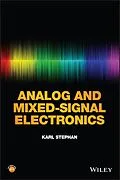A practical guide to analog and mixed-signal electronics, with an emphasis on design problems and applications
This book provides an in-depth coverage of essential analog and mixed-signal topics such as power amplifiers, active filters, noise and dynamic range, analog-to-digital and digital-to-analog conversion techniques, phase-locked loops, and switching power supplies. Readers will learn the basics of linear systems, types of nonlinearities and their effects, op-amp circuits, the high-gain analog filter-amplifier, and signal generation. The author uses system design examples to motivate theoretical explanations and covers system-level topics not found in most textbooks.
* Provides references for further study and problems at the end of each chapter
* Includes an appendix describing test equipment useful for analog and mixed-signal work
* Examines the basics of linear systems, types of nonlinearities and their effects, op-amp circuits, the high-gain analog filter-amplifier, and signal generation
Comprehensive and detailed, Analog and Mixed-Signal Electronics is a great introduction to analog and mixed-signal electronics for EE undergraduates, advanced electronics students, and for those involved in computer engineering, biomedical engineering, computer science, and physics.
Autorentext
Karl D. Stephan, PhD, is Professor in the Ingram School of Engineering, Texas State University, USA. Dr Stephan has published six book chapters and over 80 journal and conference papers in the fields of micr wave engineering, atmospheric physics, the history of technology, and engineering ethics.
Klappentext
A PRACTICAL GUIDE TO ANALOG AND MIXED-SIGNAL ELECTRONICS, WITH AN EMPHASIS ON DESIGN PROBLEMS AND APPLICATIONS
This book provides an in-depth coverage of essential analog and mixed-signal topics such as power amplifiers, active filters, noise and dynamic range, analog-to-digital and digital-to-analog conversion techniques, phase-locked loops, and switching power supplies. Readers will learn the basics of linear systems, types of nonlinearities and their effects, op-amp circuits, the high-gain analog filter-amplifier, and signal generation. The author uses system design examples to motivate theoretical explanations and covers system-level topics not found in most textbooks.
This book features the following:
- Provides references for further study and problems at the end of each chapter
- Includes an appendix describing test equipment useful for analog and mixed-signal work
- Examines the basics of linear systems, types of nonlinearities and their effects, op-amp circuits, the high-gain analog filter-amplifier, and signal generation
Comprehensive and detailed, Analog and Mixed-Signal Electronics is a great introduction to analog and mixed-signal electronics for EE undergraduates, advanced electronics students, and for those involved in computer engineering, biomedical engineering, computer science, and physics.
Inhalt
Preface xi
Acknowledgments xiii
About the Companion Website xv
1 Introduction to Analog and Mixed-Signal Electronics 1
1.1 Introduction 1
1.2 Organization of the Book 3
1.2.1 Chapter 2: Basics of Electronic Components and Devices 3
1.2.2 Chapter 3: Linear System Analysis 3
1.2.3 Chapter 4: Nonlinearities in Analog Electronics 3
1.2.4 Chapter 5: Op Amp Circuits in Analog Electronics 4
1.2.5 Chapter 6: The HighGain Analog Filter Amplifier 4
1.2.6 Chapter 7: Waveform Generation 4
1.2.7 Chapter 8: AnalogtoDigital and DigitaltoAnalog Conversion 4
1.2.8 Chapter 9: PhaseLocked Loops 4
1.2.9 Chapter 10: Power Electronics 5
1.2.10 Chapter 11: HighFrequency (RadioFrequency) Electronics 5
1.2.11 Chapter 12: Electromagnetic Compatibility 6
Bibliography 6
Problems 6
2 Basics of Electronic Components and Devices 8
2.1 Introduction 8
2.2 Passive Devices 9
2.2.1 Resistors 9
2.2.2 Capacitors 11
2.2.3 Inductors 12
2.2.4 Connectors 13
2.2.5 Antennas 14
2.3 Active Devices 15
2.3.1 Diodes 15
2.3.2 FieldEffect Transistors 17
2.3.3 BJTs 22
2.3.4 Power Devices 24
Bibliography 29
Problems 30
3 Linear Systems Analysis 33
3.1 Basics of Linear Systems 33
3.1.1 Two-Terminal Component Models 34
3.1.2 TwoPort Matrix Analysis 42
3.2 Noise and Linear Systems 48
3.2.1 Sources of Noise 49
3.2.2 Noise in Designs 53
Bibliography 56
Problems 56
Project Problem: Measurement of Inductor Characteristics 59
Equipment and Supplies 59
Description 59
4 Nonlinearities in Analog Electronics 62
4.1 Why All Amplifiers Are Nonlinear 62
4.2 Effects of Small Nonlinearity 63
4.2.1 SecondOrder Nonlinearity 63
4.2.2 ThirdOrder Nonlinearity 67
4.3 LargeScale Nonlinearity: Clipping 69
4.4 The Big Picture: Dynamic Range 74
Bibliography 76
Problems 76
5 O p Amp Circuits in Analog Electronics 78
5.1 Introduction 78
5.2 The Modern Op Amp 80
5.2.1 Ideal EquivalentCircuit Model 80
5.2.2 Internal Block Diagram of Typical Op Amp 81
5.2.3 Op Amp Characteristics 85
5.3 Analog Circuits Using Op Amps 88
5.3.1 Linear Op Amp Circuits 92
5.3.2 Nonlinear Op Amp Circuits 105
Bibliography 115
Problems 115
6 The HighGain Analog Filter Amplifier 124
6.1 Applications of HighGain Filter Amplifiers 124
6.1.1 AudioFrequency Applications 125
6.1.2 Sensor Applications 126
6.2 Issues in HighGain Amplifier Design 130
6.2.1 DynamicRange Problems 130
6.2.2 Oscillation Problems 131
6.3 Poles, Zeroes, Transfer Functions, and All That 134
6.4 Passive Analog Filters 137
6.4.1 OnePole Lowpass Filter 137
6.4.2 OnePole, OneZero Highpass Filter 141
6.4.3 ComplexPole Bandpass Filter 143
6.4.4 Bandstop Filters 149
6.5 Active Analog Filters 149
6.5.1 SallenKey Lowpass Filter with Butterworth Response 150
6.5.2 Biquad Filter with Lowpass, Bandpass, or Highpass Response 158
6.5.3 SwitchedCapacitor Filters 162
6.6 Design Example: Electric Guitar Preamp 164
Bibliography 169
Problems 169
7 Waveform Generation 175
7.1 Introduction 175
7.2 Linear SineWave Oscillators and Stability Analysis 176
7.2.1 Stable and Unstable Circuits: An Example 176
7.2.2 Poles and Stability 180
7.2.3 Nyquist Stability Criterion 181
7.2.4 The Barkha...
